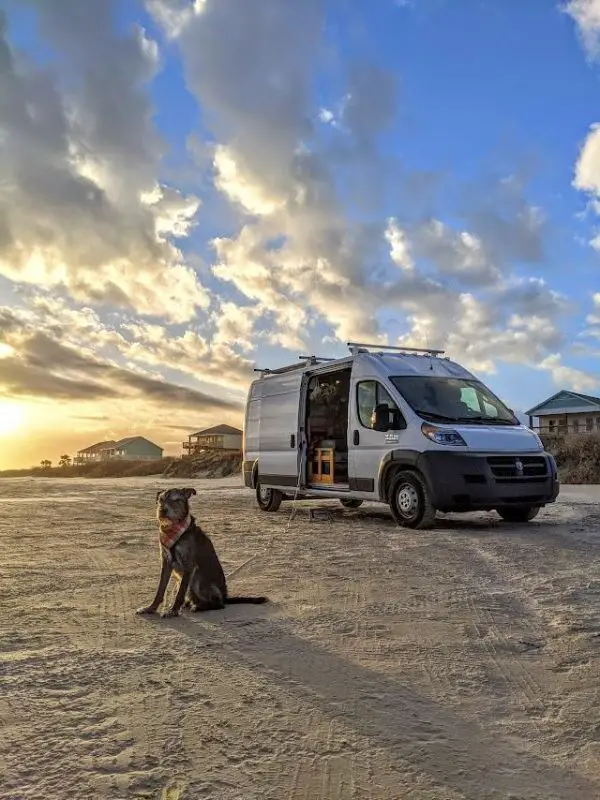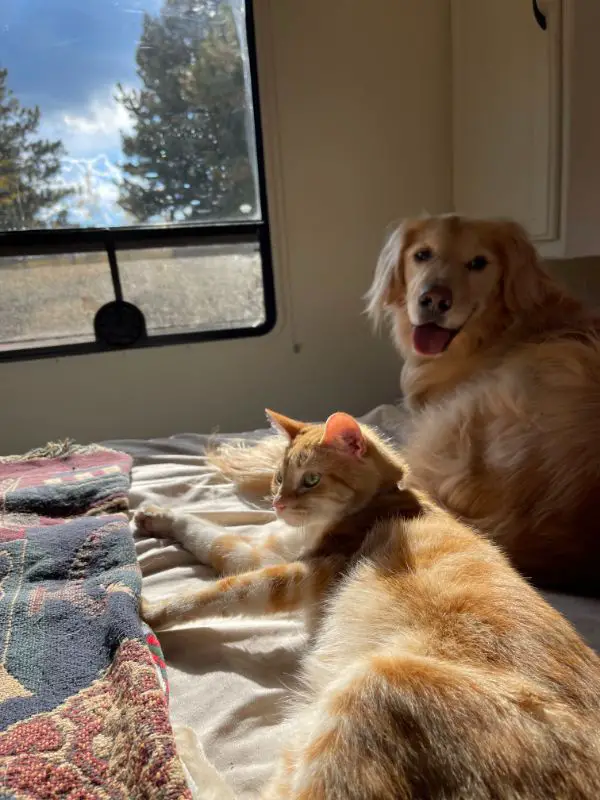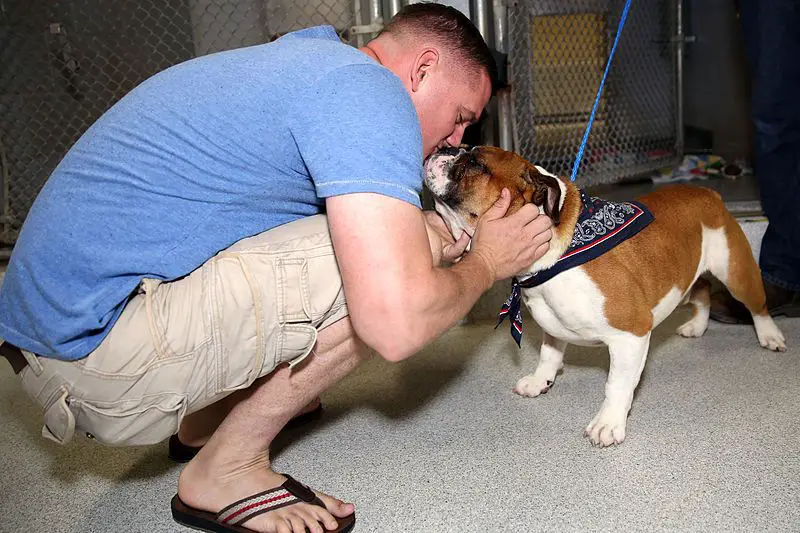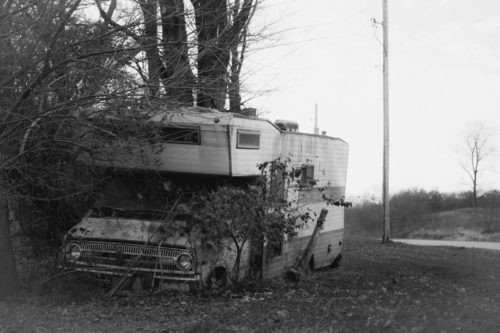The Good, the Bad and the Ugly of RVing with Pets – the blunt truth: what people love, hate, and wish they could change about RVing with pets.
For a pet owner, the hardest part about taking a trip can be leaving them behind. You miss them. They miss you. Money, favors from friends or family, stress. All are things to consider and worry about when leaving your pet for an extended period of time.
But what if you didn’t have to? What if you took them with you on your road trip? What would that look like?
Let’s delve into the good, the bad, and the ugly of bringing your pets with you on an RV trip.
NOT HAVING TO PAY FOR BOARDING!
Let’s start out with a positive. It can be expensive to board any animal, ranging from about $20-$60 a night for dogs and a little lower for cats at an average of about $25 a night. If you are choosing not to board, you typically have to leave the animal with someone or have someone come check on them or even pet/ house sit. If you aren’t paying out actual cash, you’re typically asking for favors.
If you take your pet with you, you don’t have to pay those fees or cash in those favors from friends and family. You don’t have to worry about how well they are actually being treated at the boarding place or if they are stressed even with your friends or family.
GETTING THEM ACCUSTOMED TO THE RV

Hopefully, your pet already loves riding in the car, but don’t immediately assume they can’t come with you if they don’t love it currently. There are a number of things you can do to get them more accustomed to the vehicle so they feel more comfortable. Before going on the trip, plan to have the RV available for some closer-to-home activities.
- First, you can simply bring them on the parked RV and play with them in there so that they have a more positive association with it and get used to it.
- It’s also recommended to do some of this while the vehicle is turned on while parked so they get used to sounds, vibrations, etc.
- You can then do some quick trips around the area with them so they get used to the vehicle moving.
- You can also have everyone (pets and humans) spend a night in the RV in the driveway to get adjusted.
All these will help the pet have a more positive association with the vehicle as well as let you test everything out.
Some may still whine or seem a little nervous even after all this. Some will get used to everything after being on the road for a few days. Some won’t. There may still be pets who are still very uncomfortable with the RV after all this. Therefore, it might be a good idea to have a backup plan in place in case they are not suited for RV life after all. You, unfortunately, will have to make that call.
PACKING FOR YOUR FURBABY
Before you head out, you want to make sure that you will have everything that you will need for your pet. Consider taking them in for a check-up with their vet shortly before the trip and ask if there is anything, in particular, you should plan to bring/ get set up/ keep in mind for your pet. Some common supplies include:
- Food
- Water
- Bowls (more permanent ones for the RV and portable ones for when you are out and about)
- Treats (having a lot of these on hand is a good idea to help continually use positive reinforcement)
- Toys and other items of comfort
- Bins for storing everything
- Poop bags/ litter supplies (litter, box, trash bags, etc.)
- Medications
- Copies of vaccination records (both hard and electronic copies are recommended)
- Tags
- Leashes, harnesses, booties, other gear if applicable (i.e. life jackets, goggles, coats/ jackets)
- Cleaning supplies
- Pet First Aid kit
- Vet’s phone number/ other contact info for questions on the road
Yes, you can often find a pet store to pull into if you forget something, but doing your best to plan ahead will reduce these emergency stops.
PRACTICE AND TEST ROUTINES AND LOGISTICS
Before the trip, make sure to set up some routines and logistics for your pets. These will help keep your pets safe, healthy, and comfortable for your trip. Use your already existing knowledge of the pet’s comfortability levels and existing routines to set up something similar.

Riding in the Vehicle
- Will they be in a crate, seatbelted in with a harness, or “loose” in the vehicle? (the last option is typically not recommended for safety)
- Will they jump into the vehicle themselves or will they need you to pick them up? Or will they need other assistance like stairs?
- Do they enjoy music or talk show radio? Our cat will cry the whole trip if we have a podcast on (unfortunately) or just talk with no other auditory accompaniment, but play some music and he is just fine.
Bathroom Breaks/Litter Box
Dog
- How often will your dog need a bathroom break?
- How do they normally let you know?
- How can you adapt this routine to the RV?
Cat
- Will you have a litter box available all the time for them? How will they access it while keeping it contained on the vehicle? You do not want litter being flown around your RV from a hard stop or turn.
- Will you toilet train them to go on command or outside on a schedule? How often will you clean it?
Other animals: how will they be set up for these concerns?
Food and Water
- Is your animal used to food and water being available throughout the day? If so, how can you contain the food, water, and containers while you are driving?
- You do not want food and water spilling on your first big turn on the trip. There are devices that let the animal essentially push a button to get food or water if you can train them to use it, but they still need to be secured.
- If they won’t always be available, how often will you offer them to your pet? Where are they located for easy access?
Leaving the RV
- Will they be leaving the RV with you at any point?
- How will you contain them to ensure they don’t bolt out while you are leaving either with or without them?
- Where will leashes, harnesses, etc. be located for easy access?
- Can you train them to sit and wait for a release command?
- Make sure to talk to them! Any pet owner knows that they can understand you, at least to a degree. Tell them when it’s time to go, that it’s a potty break, it’s food time, walk time, etc. This will help them know what to expect.
Again, planning ahead and trying to implement any of these routines or training ahead of time will help make sure that they are more comfortable on the trip.
There will likely be some learning along the way for everyone so be patient and be prepared that things may not go perfectly, especially for the first couple days, so plan for that.
- Plan for a bathroom break an hour into your drive just to make sure that they can go if they didn’t before you left.
- Know that you will probably have to clean up something at some point even with the maximum amount of prep beforehand so have cleaning supplies ready.
- Do your best to stay calm when it happens. It’s frustrating, but everyone’s trying to adjust to the new life and they can’t even fully understand what is happening.
WILL THEY BE ALLOWED?

Not all campgrounds allow pets. Of the ones that do allow pets, many have rules on what pets they will accept, what they are allowed to do on the property, etc. Dogs, in particular, can have extra restrictions including the size, breed, and/ or the number of dogs. Many also require your pet’s vaccination records, especially rabies, so make sure that you have copies of those. Barking may be a concern for other campers. Calling ahead of time is highly recommended to ensure that your furry friend(s) will be allowed to stay with you.
Pets may not be allowed on all of the activities you want to do on your trip. From day excursions to even meals at restaurants, your pet may be denied entry. Make sure to keep them in mind for these activities, or that you have plans for them during that time. There are also apps like Find Fido that keep track of dog-friendly locations.
STAYING AT THE CAMPGROUND/ IN THE RV
Make sure you know the guidelines for your pet for staying at the campground. Some questions to ask include:
- Are they allowed to be off-leash near my RV? (if your dog is trained to do so)
- Can I set up temporary fencing around my RV? (Temporary fencing will let your dog stay outside the RV and have a bit more freedom. Not all campgrounds will allow this or have the right terrain for this. Your dog will also have to be well-behaved enough that jumping, digging under, or otherwise pushing/ destroying the fencing is not a possibility.)
- Where are they allowed to go to the bathroom?
- Are there any rules for disposing their waste?
- Are there areas where they are not allowed?
- Are there any other pets staying at the campground to be aware of?
There may also be times when you have to leave your pet to go off and do other things. Will they be left to roam the RV? Will they be crated in the RV for these times? Will they need food, water, or other facilities while you are gone? Consider leaving a tv, radio, music, etc. playing while you are gone to block out the outside world a little which can stress them out, prompt barking, etc.
Fans or other ways of keeping the vehicle cool are a must and consider investing in a temperature monitor like Waggle or Marcell which will give you updates on temperature changes. This can be used if you are leaving them at the campsite or even in a parking lot for a quick dinner. Still, consider how long you feel comfortable leaving them. How long would it take you to get to them if something went wrong? Will you have cell service where you are going?
If barking is a concern for your dog, there are bark collars that emit a sound to discourage barking. They seem to work well for many, providing a humane option to the barking issue.
If all of these are options that don’t work for your pet or you still feel uncomfortable, there are apps like Rover that help you find local petsitters if you don’t have someone in your party who wants to stay with them.
WHAT IF THEY GET LOST?
Losing your pet is one of the biggest fears of pet owners and the chance of it happening increases on a road trip. There are several things that you can do to help keep your animal from wandering off and help to ensure that they can get back to you if they do.
Make sure you have a routine set up with them so that they are not leaping out the door as soon as you open it. Make sure they are leashed before opening the door or they are trained to wait for your command to help reduce the chance of them getting loose.
Consider investing in at least one of the following options:
Tags:
- First and foremost, make sure that you have tags with all your correct information on them including phone numbers that they will be able to reach you at during the trip.
- Make sure that the tags are not worn before you head out and replace them if they are. It won’t help if the person who finds your pet can’t read the tags. You can purchase dog tag covers or pouches that will hold the tags and reduced rubbing which causes the information to fade.
- You can also get some cheap disposable key tags to list your campground and site number for that specific trip so that if they wander off at the campground, the people who find them can return them easily.
Chips: Getting your pet electronically chipped is another way to help ensure that your pet will be returned to you as animal shelters will be able to scan the chip and contact you. Again, make sure that it is linked to contact info that you will be able to check.
Custom embroidered collar/ harness: Getting their harness/ collar embroidered with your phone number, etc. provides yet another option even if the tags come off.
Smart Collars: It’s 2021 and we actually have new cool tech that can help you with this problem! Smart Collars can track your pet with GPS and cellular networks so that you can always find them. Some models also track all sorts of other things including exercise and sleep numbers. Make sure you are getting the right smart collar as some only focus on tracking location, some only focus on tracking fitness, and some do both.
KEEPING THEM SAFE
There is always uncertainty on an RV trip and uncertainties can spell trouble for your pet. Make sure you are vigilant in keeping them safe, such as from other animals on the campground that may not be as friendly as expected, uncertain environments, etc.
So, do what you can to plan for potential issues. Check that the RV is set up with no health concerns for your animal. Is there anything they could eat or chew up? Are there any cords that might be of concern? Do you have a pet first aid kit in an easy-to-access place for emergencies? Be prepared to help out if they need it.
PLANNING AROUND THE WEATHER
Knowing the potential weather conditions for where you are headed is even more important with pets. Be ready to adjust the RV and other plans based on how hot or cold it is and how that will affect your pet.
Use this information in planning as well. Will they be compatible with that location? Certain breeds handle heat or cold better than others. Bringing a husky to the desert or a hairless cat/ dog to winter destinations can be cruel so make sure you are planning your destinations with them in mind just as much as your needs. Even less drastic climate changes can be difficult for them, so be prepared to adjust.
When I was a teenager, my family decided to take a road trip to return the puppy we had been training to be a service dog back to their headquarters for final training. We all piled up in the minivan and drove from Texas to California during the summer. Nothing too different from what he experienced in Texas, right?
We stopped at the Hoover Dam on the hottest day of my memory. The van’s gauge read 121F so we grabbed extra water for all of us. There was an area outside that had black granite instead of the normal concrete. Suddenly, the poor boy started whining and yelping and we were trying to figure out why. My dad realized that his paws were likely scorching from the black rock in the hot sun, so he picked the poor dog up and ran off to the concrete area. He did much better over there and we inspected his paw pads, which thankfully looked okay.
We went to the store that night and got booties for him, something he had never needed even when walking around on asphalt in triple-digit weather in Texas. We let him test them out in the hotel room that night, entertaining all of us as he got used to them being on his feet. Be sure to give them time to test out new equipment beforehand as opposed to in the moment as they will often not be ready to go if it is a brand-new experience.
BE READY TO LISTEN TO THEM!

This is the number one thing to remember. Work with them on setting your routine. Learn how long they are typically comfortable driving in a stretch, but you must always be prepared to be flexible and listen to them. Things happen, even to the best of us and the same is true for them. Unplanned pit stops, as well as supply runs, will happen. Accidents will happen. Be prepared to help.
Notice how they are reacting to everything and not just in the beginning. Even the animals that love RVing may want a break for a bit. If your pet seems more anxious and uncomfortable than normal, it may be time to look at taking a break somewhere if possible before hitting the road again.
AND THE BEST PART IS …
At the end of the day, if you can get all the logistics sorted out and they can handle the trip well, you get to see them every day and experience everything on the trip with them. Waking up every day to their faces and being able to play with them is the best thing you could ask for.
You don’t have to lay at night wishing your pet was cuddling there with you, because they will be right there with you.
And many animals enjoy the travel. There are adventure dogs and cats who go hiking, kayaking, swimming, and more with their owners. Your pet may not be that well suited for the trip, but they often enjoy it and… you never know. They could be if you gave them the chance.
Sarah Hoffschwelle is a freelance writer who covers a combination of topics such as science, self-development, art, and societal commentary. In the past, Sarah worked in educational nonprofits providing free-choice learning experiences for audiences ages 2-99.
-
Sarah Hoffschwellehttps://changingears.com/author/sarah-hoffschwelle/
-
Sarah Hoffschwellehttps://changingears.com/author/sarah-hoffschwelle/
-
Sarah Hoffschwellehttps://changingears.com/author/sarah-hoffschwelle/









